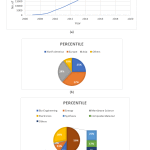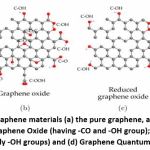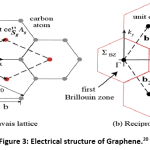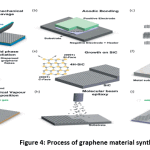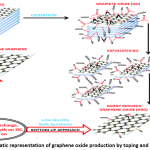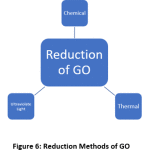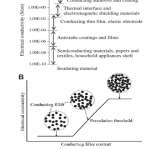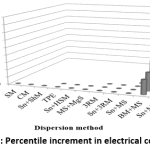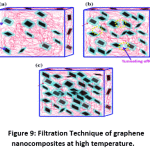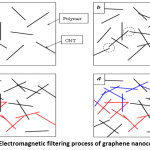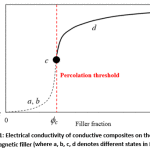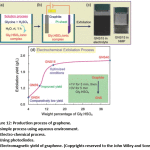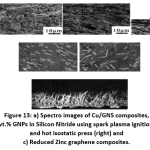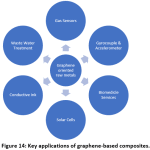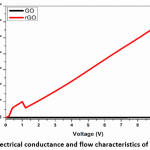Electrical and Chemical Properties of Graphene over Composite Materials: A Technical Review
Introduction
The field of material science, nanotechnology, and electromechanical studies has developed beginning late and the centrality of this subject growth in the gathering of jobs as the vehicle, flying, bundling, gadgets, biotechnology, adaptable sensors, and different unmistakable applications.1-3 In such way, the enhancements polymer nanocomposites subject to graphene materials have changed into a most imperative advancement. Graphene is a two-dimensional structure of carbon having crystal structure (hexagonal), high surface area, electron transportability, high conductivity, and electromechanical quality. It has various uses in different fields consisting hardware and biomedical machines and in antenna design.4-8 It assumes an indispensable job in the upgrade of the relationship between the sheets and polymer material. Graphene-based composite materials are mainstream for material authorities now a days for their crucial improves would result in properties affecting progressively extraordinary applications. In view of its slight physical proximity and helpful electrical, mechanical, physicochemical properties graphene is getting mainstream for the essential vitality fields. Its properties are exceptionally encouraging and is steady for the application.9, 10
Figure 1: (a) Published verified researches on graphene in recent decade (2007-17), (b) continent wise selection and (c) by applications.3-28
In the accompanying areas, the authors condensed most recent results in that material’s processing methods, properties and developments in their composites area. Besides, as a vital piece of this audit, we likewise close natural applications and lethality and safe dealing with conventions to relieve related well being suggestions while utilizing this product as nanomaterials may provide helpful data for the exploration of this zone. The development of this examination area can be obvious from the production record appeared in Fig. 1.
Composition and Chemistry of Graphene Materials
Graphene is the slenderest material in its closeness materials. It has high quantum battle influence, warm conductivity, high Young’s modulus (1 TPa) and unavoidable nature of 130 GPa,12-17 heat confirmation properties as a solitary sheet. It exhibits the ambipolar electric field influence with section voltage. Graphene has the strongest structure among all other carbon composites, even more than diamond structure.18 The chemical and structural details of graphene is delineated in Fig. 2 and Fig. 3.
Figure 2: Structures of graphene materials (a) the pure graphene, and the chemically modified graphene, including (b) Graphene Oxide (having -CO and -OH group); (c) Reduced Graphene Oxide (having only -OH groups) and (d) Graphene Quantum Dot (GQD).19
Figure 3: Electrical structure of Graphene.20
Graphene as a material is nothing, but when it is reduced or converted into some composites like GO, rGO, fGO and etc. then it gets high enough properties to be utilized in various practical engineering and bio-medical works. The production of graphene takes 7/8 sequential processes namely micromechanical cleavage, anodic bonding, photo exfoliation, liquid phase exfoliation, Processing Silicon Carbide and etc. The process of extracting graphene is depicted in Fig. 4.
Figure 4: Process of graphene material synthesis.
Hung et al.,21 verified the GO outwardly of surfaces by an electrophoretic sworn explanation procedure, to help the interlaminar shear nature of composites. The technique is unobtrusively fundamental and quicker. GO is inconceivably used for composites like fiber braced polymer. Carbon fiber and carbon surfaces can be successfully encircled by GO to expand the interfacial holding properties through wrapping polymer cross region of the composites. By changing over graphene into fiber the holding limit of the material expanded.21-23 Be that as it may, the framework might be superfluously expensive because of the treatment of every fiber is required. A scientist named Hung along with his team verified the GO outwardly of surfaces by an electrophoretic sworn articulation method, to help the interlaminar shear nature of composites. The method is unassumingly essential and speedier. At severely low temperature and humidity, the UTS and Young’s modulus of the composites were refreshed, which is the advantage temperature level of standard flying machine flying at tropopause layer,24, 25 GO is utilized as a dielectric material. Between carbon surface layers a flimsy film of GO layer is implanted which act a terminal to outline a fundamental capacitor. GO film likewise can be utilized as a convincing medium to limit essentialness. The range is about 15V to 1500V.26 An energized layer of GO film can be settled between layers (carbon) which act a terminal at the surface to outline an essential energy storage device. Because of the growing enthusiasm for unmanned air vehicles (UAVs), the imperativeness amassing cutoff and load of battery reliably limit their fight length.
Preparation Methods
A large portion of the exploration contemplates have not utilized graphene in its unadulterated shape (immaculate graphene) because of its restricted yield from the arrangement perspective. Additionally, graphene subordinates, for example, GO, rGO and frGO have turned out to be even more generally accessible and feature comparable properties to that of graphene. The different advances are given beneath.
Combination of Materials
Little-scale mechanical stripping, mixture vapor dissemination (CVD), liquid stage decline of graphene oxide and epitaxial advancement are the four assorted built systems for graphene.27 Those methods are accumulated as a best up or best down terminology, among which mechanical stripping and vapor dissemination are traversed directly to liquid stage on ground of temperature. Different methods are used to produce graphene oxide as graphene itself does not reacts with oxygen in normal condition. Fig. 5 demonstrates the toping and bottoming cycle for the production of graphene oxide.
Figure 5: Schematic representation of graphene oxide production by toping and bottoming cycle.
Liquid Stage Partition
A scientist named Mr. Brodie was the first ever man who experimentally synthesized graphene oxide along with fGO.28 He used KClO3 to oxidize graphene along with graphite and HNO3 (vap) mixture as reacting agent which improved the synthesis rate of GO and to ensure the purity of the blend. This process though was successful but a temperature issue was very alarming issue as when GO is produced then huge temperature is also generated and this can blast the whole system. To mitigate this temperature issue, carbon nanotubes was introduced as HNO3 does not react with pure carbon and it is neutral in normal condition and can also work as an insulator.29, 30 But this system was also not so successful as using carbon nanotubes, HNO3 (v) and KCLO3 mixture produce harmful NO2 and N2O4 above 200OC. To restrain this problem, Boron rods hugely used in nuclear reactors has been introduced which can suck excess energy and thus causing less harmful gas production.31
Synthetic Vapor Affidavit
Little scale mechanical, CVD, and epitaxial improvement approaches to manage yield graphene have ended up being ordinary, a couple of minor takeoffs from these systems have been developed.32 The move to move headway of graphene on copper foils has been showed up as of late. Supercritical liquids have the ability to control the chemical equilibrium of any nanoparticle synthesis which is also true for graphene and its subordinate materials like gO, rGO, frGO and etc. But using supercritical liquids cannot be thought as an alternative as the cost and maintenance both gets higher for the production system.33, 34 More research should be done in this sector.
Synthesis of GO
Graphene on reduction produces Graphene Oxide, on further reaction with oxygen GO turns into a new material having great electrical properties like very high electric conductivity.35 This material is known as rGO (reduced GO), this is mainly processed to improve the quality of GO which can be more useful in electrical sectors. rGO have different types and shapes though being the same chemical property as GO.36 Fig. 6 shows the process of reducing GO.
Negative Blend: Readiness of GO and diminished rGO in enormous size, utilizing a persuading and clear system,37 wherein GO tests is submerged into a picked engineered lessening master for a specific trimline allotment and a rise in temperature. This strategy sequentially empties the pointless down to earth social events, for instance, COOH and OH.
Figure 6: Reduction Methods of GO
Temperature Effect
The warm rot of GO is progressively capable in passing on extraordinary rGO powders than the majority of the materials. In this strategy, the GO is decreased under higher temperature (above or around 1000 °C) where water particles and oxygen reasonable parties will be dispersed and ate up.38-44
Ultra-Violate Effect: In this procedure, GO is appeared to UV light after it is ousted from graphite. If the powder GO is to diminish, it will manage in doubt be dispersed in a dissolvable as the liquid region of GO holds more UV light making unfathomably decreased GO.45, 46 Guo et al., proposed a method in which graphene nanosheets are electrochemically reduced to GO suspension, in which a three-cathode framework as a power supply and blended for 2 h. A strong π-π or ionic facilitated exertion are made in the wake of cleansing these steady gatherings that improve the properties. While the GO rot by substance/electrochemical reduction has seen commonsense diminishing segments, the warm decline of GO is in like manner by and large used. Fast warming of GO to 1000 °C depletes these utilitarian parties and likely makes unimaginably diminished rGO in the edge powders.47, 48 Clearly, this can’t hold the film sort of GO which is a negative stamp.
Electrical Properties of Graphene Materials
Most polymers behave like insulators. Therefore, the addition of conducting fillers could transform these insulators into conductors. The conducting fillers like carbon derivatives (GNPs, CNTs, EG, etc.) could be used for improving the electrical conductivity of polymer composites. The percolation theory could be used to explain the electrical conduction mechanism of the composites. At the beginning, the loading of the fillers is low; therefore, the polymer matrixes dominate the electrical conductivity of the composites, and the composites behave like insulators. When the loading increases to a certain point, the electrical conductivity of the composites steeply increase by several orders of magnitude, and this loading is called as the percolation threshold. After this loading, continuous electron paths are formed in the composites, and the insulators are transferred to conductors.49 A figure demonstrating the applications of electrical conducting composites and the percolation threshold and conducting network is given in Figure 16. However, direct contact between the conducting fillers is not necessary owing to the tunneling effect; this is also the reason why composites have low percolation thresholds.
Both Munson-McGee and Balberg found that nanofillers orientation plays a major role in forming the permeation edge arranges; the two of them announced that expanded filler arrangement prompts an expansion in the permeation edge,50, 51 Stankovich et al., detailed a low permeation edge of about 0.1 vol% for graphene polystyrene composites and found the electrical conductivity of the composites had increased from 0.1 to 1 S/m when the graphene volume fraction rose from 1 to 2.5 vol% . They believed that the high aspect ratio of graphene and homogenous dispersion states contributed to such a low percolation threshold and high electrical conductivity of the composites. It appears that, the lowest percolation threshold of about 0.07 vol% was reported in graphene-reinforced polymer composites.52 Concerning CNT-reinforced polymer composites, a percolation threshold about 0.15 vol% of the MWCNTs/HDPE composite has been reported.53 A high electrical conductivity of about 27 S/m has been reported by Xue Wang and his group; they achieved this high value by the method of in-situ polymerization. They assumed that high electrical conductivity can be achieved by a higher level of polypyrene doping.54
Figure 7: Applications of electrical conducting composites (A) and conducting network of composites (B).
Fitting the electrical properties of graphene can open its numerous potential electronic applications.55-56 For instance, viable measure fields are presented when graphene grid twisting happens. Like the powerful attractive field, the created successful measure fields influence the Dirac fermions. The Fermi level in undoped graphene lies at the Dirac point, where the base conductivity esteems are accomplished.57 By including free charge bearers (i.e., dopants), the electrical properties of graphene can be improved, and conductivity increments straightly with transporter thickness. For instance, boron as dopant can contribute ~0.5 bearers per dopant in a graphene sheet. Dopants can be presented during the combination of graphene utilizing concoction vapor statement (CVD). The variety in electrical conductivity with different types of graphene and graphite nanocomposites is condensed in table 1, and the influence of scattering mode on the improvement of warm conductivity is appeared in the Figure beneath. The most extreme improvement in electrical conductivity was seen on account of a mix of ball processing and mechanical mixing. Consequently, both warm and electrical conductivities improved on account of mechanical mixing.
Figure 8: Percentile increment in electrical conductivity.
Electrical Conductivity of Graphene Polymer Nanocomposites
Pervasive electrical conductivity is the most critical property of graphene. Exactly when graphene fills the securing polymer organize, conductive polymer composites results in namely PMMA, PVA, PVC, PP, PE, PA12, PS, etc.58, 59 Such composite materials, all things considered, showcase a non-straight augmentation of the electrical conductivity as a part of the filler obsession. The two parameters, electrical conductivity, and pervasion utmost are as one related with.
A theoretical report by Xie et al.,60 foreseen that graphene is more convincing for conductivity improvement than fighting nanofillers, for instance, CNTs because of their colossal unequivocal surface area. Ruoff et al.,61 consolidated graphene/PS composites and they watched a low pervasion limit at 0.1 vol% of graphene. Here, the strategy is explained with a Graphene filled polymer. At first, the conductivity is low (Fig. 9a) in light of less included substances, yet huge gatherings constantly begin to shape (Fig. 9b) with a slight augmentation in conductivity. At this stage, tunneling effects occur between neighboring graphene pieces, making it supportive in Sensing materials.
Figure 9: Filtration Technique of graphene nanocomposites at high temperature.
As the graphene pieces fabricate, an all-out conductive way (red) is molded by the achieving chips (Fig. 9c) at the pervasion, and further augmentation in the main particles redesigns the amount of coordinating systems, as showed up in Fig. 9c.62 Various components sway the electrical conductivity and the penetration furthest reaches of the composites, for instance, gathering of filler, accumulation of filler, planning procedures, functionalization and perspective extent of graphene sheets, between sheet crossing point, scattering in the structure, wrinkles, and wrinkles, etc. In this portion, the authors tried to keep an eye on of DC properties of nanocomposites. All around, by dynamically filling some regular conductive filler particles, into securing polymers, the assortment of electrical conductivity of composites can be apportioned into three stages, as showed up in Figures 10 (b) to (d). In any case, it should be seen that, in Figure 10(c), some colossal fissions related by CSFs are constantly confined. There are some CSFs which are close to each other. Accordingly, in this state “b”, the electrical conductivity of composites augments constantly due to tunneling impacts among those neighboring CSFs, in spite of the way that there is no completed conductive path formed by coming to CSFs. As explained later this state “b” is huge for the piezo resistivity of nanocomposites.
Figure 10: Electromagnetic filtering process of graphene nanocomposites.
In this subsequent stage, the electrical conductivity of composites strikingly follows a saturation control law as showed up in Figure 11. This methodology is named as the penetration technique. The volume division of filler particles at this stage is called as far as possible, i.e., in Figure 11. It was found that the electrical lead of nanocomposites using CNTs as conductive filler particles in polymer systems, e.g.,63-76 seeks after the similar saturation action to that communicated above for standard conductive filler particles, e.g., CSFs. Here the authors just reviewed some new pieces of literature on the electrical saturation method of CNT/polymer nanocomposites, and one can suggest the remarkable review article by Bauhofer and Kovacs78 for progressive point by point information. In the test contemplates in this field, at present, liquefy blending exacerbating,78-80 relieving/in situ polymerization64, 65, 68, 69, 71-76, 81-84 and coagulation is broadly used to set up this sort of nanocomposites utilizing CNTs.
Figure 11: Electrical conductivity of conductive composites on the basis of electromagnetic filler (where a, b, c, d denotes different states in Figure 10).
Dependent upon the kind of polymers and advancement similarly as the sort of CNT materials used, saturation points of confinement reaching out from under 1.0% to over 10.0 wt.% of CNTs stacking have been observed probably.69, 85 For example, for SWNTs, Nogales et al.,63 associated an in-situ polycondensation reaction to prepare SWNT/PBT nanocomposites. In this experiment, an electrical saturation edge as low as 0.2 wt.% of SWNTs stacking was achieved. Ounaies et al.,64 have analyzed the electrical properties of SWNTs and got conductivity of penetration with a low saturation edge of around 0.1 wt.%. It is possible to control the electrical properties of SWNT/polymer composites through the methodology of courses of action of SWNTs which was proved by a team of scientists headed by Mr. Park.65 In recent studies, it considered that the electrical properties of SWNTs filled in the dissolvable polymer poly(3-octylthiophene) uncovered penetration edge is around 11.0 wt.%.66, 67 Further experimentation done by Dr. Kymakis proved that cleaned SWNTs lead to a much lower pervasion edge of around 4 wt.%.
For MWNTs, Sandler et al.,68 have used MWNTs with an epoxy polymer reliant on bisphenol-A gum and a fragrant hardener, and they got a lower penetration limit at around 0.04 wt.%. The improvement of sums was in a like manner recognized. On their another examination,69 the makers uncovered the most diminished pervasion edge up to the present date, i.e., 0.0025 wt.% using MWNTs. To procure a low saturation limit, using MWNTs and epoxy, Martin et al.,70 investigated the effect of system parameters used in an in-situ polymerization creation process, for instance, blending rate, sap temperatures and easing temperatures. Uniform dissipating of MWNTs all through PET cross section was asserted by transmission electron microscopy (TEM) and separating electron microscopy (SEM).71-74 The saturation breaking point was around 0.9 wt.%. Thus, the present designers orchestrated the MWNT/epoxy nanocomposites and gained a low pervasion cutoff of 0.1 wt.%. The effects of reestablishing process, mixing speed, mixing time, an extension of ethanol, the timing of hardener development, etc., in the assembling method on the electrical properties of nanocomposites have been inspected in detail.75, 76 It was found that the reestablishing temperature and the mixing conditions are key factors in the creation strategy, which affect the game plan of a driving force by and large. Subsequently, the wary structure of these parts in the creation technique is required to achieve high electrical presentations of nanocomposites. A three-move preparing strategy was also used to improve the dispersing of CNTs77 to get the incredibly conductive CNT/epoxy nanocomposites. All the above test studied have given the moderately consistent conductivity at high CNT loadings, which reaches out from a couple of S/m to a couple of numerous S/m. Generally, there are two key issues being tended to in various past exploratory examinations: dissipating of CNTs in a polymer system and association among CNTs and polymer. For the principle issue, as a result of the high surface-to-mass extent of CNTs, sub-nuclear scale forces and participation should be considered among CNTs. van der Waals controls as a general rule advance flocculation of CNTs, while electrostatic charges or steric effects lead to an alteration of the dissipating through horrifying forces.76-82 As a result, by considering the possibility of a pervading framework surrounded by fine filler particles, e.g., CNTs, the equality of the two components of pivot effects plot above should be considered. For the subsequent issue, the manner in which that the nanotubes in the composites were secured or exemplified with a slight ensuring polymer layer was recognized for SWNTs83 and MWNTs.
Differentiated and the above epic proportion of preliminary considerations, unfortunately, there have been not a lot of deliberate theoretical or numerical investigations went for comprehensively understanding the electrical traits of CNT/polymer nanocomposites. For instance, as far as the possible worth was directed by a numerical model64, 76, 84 with randomly scattered CNTs in a polymer and by an accurate formula from the ousted volume approach reliant on the quantifiable saturation theory.85 For the electrical conductivity, a micromechanics typical technique subject to assign volume segment (RVE) model was made to assess the effects of electron bouncing and the advancement of conductive frameworks on the electrical conductivity of CNT/polymer nanocomposites.86 In all honesty, for some electronic composites with some standard conductive filler particles, e.g., CSFs or carbon chips, there have been some theoretical or numerical examinations reliant on the regular quantifiable saturation model,87-90 especially for estimates of penetration edge. Made by the present makers91 may to some degree answer this request. In,92 for a securing polymer with an unpredictable scattering of CNTs, directly off the bat, in light of the quantifiable pervasion model, a three dimensional (3D) numerical model with two stages for looking at the electrical properties of nanocomposites at and after the saturation edge was made. In the essential stage, the saturation edge was foreseen at the volume division of CNTs when the chief finishes electrically conductive path related by some CNTs is formed in the polymer structure. Effects of various segments, for instance, twisted conditions of CNTs, gathering of CNTs and tunneling sway among CNTs on the electrical properties of nanocomposites have been pondered.
Chemical Properties
Graphene is a pure type of carbon in which each particle is accessible for concoction response from different sides. Particles at the edges of a graphene sheet have unique chemical reactivity. It has the most elevated proportion of edge atoms. Impurities inside a graphene sheet increase its substance reactivity. In 2013, a team of physicists of Stanford University declared that singular layer graphene is about a hundred times more artificially responsive than thicker sheets. Its thermal conductivity and mechanical strength may coordinate the astounding in-plane characteristics for graphite (around 3,000 Wm-1K-1 and 1,060 GPa, independently); their break quality should be proportionate to that of carbon nanotubes for practically identical sorts of defects, and progressing examinations have seemed individual graphene sheets have exceptional electronic transport properties. Graphite, shoddy and available in colossal sum, tragically does not immediately shed to yield individual graphene sheets. Here we present a general procedure for the arranging of graphene-polymer composites by methods for complete shedding of graphite and sub-nuclear measurement dispersing of individual, falsely washed graphene bed covers inside polymer has. A polystyrene-graphene composite confined by this course shows a pervasion edge of around 0.1 volume percent for room-temperature electrical conductivity, the most insignificant uncovered a motivation for any carbon-based composite beside those including carbon nanotubes; at only 1 volume percent, this composite has a conductivity of generally 0.1 Sm-1, sufficient for some electrical applications. Our base up mixture approach of tuning the graphene sheet properties gives a path to a far-reaching new class of graphene-based materials and their usage in a combination of employments.
Graphene Extraction Using Graphite
The exfoliation of graphite into single layers of graphene sheets has pulled in impressive consideration as a result of the unordinary electronic properties of monolayers of the graphite grid.92-94 The micromechanical cleavage of graphite is the most dependable method that renders huge estimated, good graphene sheets yet in restricted amounts, which makes it reasonable for major investigations or electronic applications.95-97 For the disintegration of graphite certain solvents, for example, N-methyl pyrrolidone (NMP), dimethylformamide (DMF), and o-dichlorobenzene (ODCB)98-103 are especially fascinating, as graphite could be legitimately shed into monolayer sheets while saving its natural electrical properties. As of late, the immediate peeling of graphite has been accomplished by surface functionalization of graphene sheets with fragrant carboxylic acids in fluid arrangements. The carboxylic corrosive gatherings situated at the out of plane graphene surface settle watery scatterings of graphene hurts. In addition, it has likewise been hypothesized that specific scatterings of the 2D graphene sheet, out of all graphite allotropes, in fluid arrangements can likewise be accomplished by an expansion in the sub-atomic structure of amphiphilic particles. Without a doubt, all the more as of late a fragrant amphiphile comprising of a hydrophilic dendron and a sweet-smelling section with planar compliance has been accounted for which specifically peels graphite powder into single and twofold layer graphene sheets in watery arrangements through hydrophilic functionalization of graphene surfaces. In another precedent, graphite powder was shed straightforwardly in a watery arrangement of pyrene subsidiaries, which goes about as a scattering operator, a recuperating specialist, and an electric paste during the warm tempering procedure to deliver great single layer graphene sheets.84 Furthermore, ionic fluids have likewise been utilized to peel graphite in an ongoing model, where an answer stage system has been connected for the generation of huge territory, bilayer or trilinear graphene from graphite. Interhalogen mixes like iodine chloride (ICl) or iodine bromide have been utilized, which intercalate the graphite beginning material at consistently or the third layer making second-or-third stage-controlled graphite intercalation mixes. All the more as of late, the peeling of graphite has been done under encompassing conditions by an electrochemical technique (cf. Fig. 12) utilizing a naturally cordial glycine–bisulfate ionic complex.
Figure 12: Production process of graphene. (a) simple process using aqueous environment. (b) Electro-chemical process. (c) Using photodiodes. (d) Electromagnetic yield of graphene. (Copyrights reserved to the John Wiley and Sons).104
During this investigation, enormous scale shedding of graphite was completed in balancing out fluids, for example, N-methyl-2-pyrrolidone and by a high-shear blending strategy (cf. Fig. 12). Thusly, the shedding of amazing graphene could be accomplished in fluid volumes from several milliliters up to many liters and even past. In this manner, direct sonication and disintegration techniques (fluid stage peeling strategies) can possibly be scaled up to deliver huge amounts of single and different layer graphene or functionalized graphene that can be utilized for the creation of composites. Moreover, gram-scale generation of fantastic graphene can be accomplished utilizing these techniques by using hand crafted particles or polymers as balancing out operators, which help in expanding the yield, yet additionally restrain the re-collection of graphene. The cooperation of these useful atoms with graphene upgrades the properties of the 2D material. In any case, the division of peeled graphene sheets from mass graphite could at present be a test. In this way, further improvement in fluid stage peeling strategies is required, and more endeavors are expected to structure and orchestrate new particles with upgraded proclivity to the basal plane, lessening the yield of results and upgrading the dissolvability of the created graphene in other natural solvents, and so on.
Graphene-based polymer composites
Graphene composites can be filled in as functionalized nanosheets, fillers or films. The inorganic nanostructures utilizing metals, for example, gold, silver, etc are composited to graphene either by ex-situ hybridization or in-situ-crystallization systems.103-107 All around, these sorts of composites have been made utilizing covalently or non-covalently joined systems, for example, in situ polymerization, strategy mixing/tossing or separate fortifying or by hybridizing these specific age methodologies fittingly. Subordinate upon properties, for example, sub-atomic weight, most far off point, hydrophobicity and open social gatherings the nanocomposites can be made utilizing these four certain techniques.108-110 The techniques are, (I) the last proposition to accomplish properties and packaging/morphology for target graphene things; (ii) the quality and vocations of the graphene materials; (iii) the adaptability from research office to industry; and (iv) the quality and controllability of sparing, find that the criticalness age structures utilized in industry are conventionally the shedding of graphite, stripping/lessening of graphite oxide and CVD.111-114 The inorganic nanostructures utilizing metals, for example, gold, silver, etc are composited to graphene either by ex-situ hybridization or in-situ-crystallization technique. Graphene composites can be set up as functionalized nanosheets, fillers or films. The covalent, non-covalent functionalized graphene-based nanosheets were associated as 2D models for polymer progress, and the dissolvability to the extent anybody knows is reached out with these composites.115 Graphene-based filler materials have the properties of electrical, warm and mechanical which improved it. In any case, layered graphene polymer motion pictures are unequivocal for photovoltaic and stack bearing film applications. Chen et al.,116 had utilized atomic estimation blending framework and start plasma sintering procedure to make copper-GNP composites. The resultant composites, the mechanical execution of the copper that at first refreshed the quality by the progress of graphene began to handicap after an estimation. Finally, the break stretching out kept decreasing from 30% to 3.5%. In spite of what might be normal, the yield quality floods up to 310 MPa at the graphene stacking of 0.6 vol.% and after that decays to 200 MPa at 4.0 vol.% of graphene growth. In like way, there are report displaying interface duetting in composites being caused in light of the poor getting a charge out of among copper and carbon. Microstructures of the composites are appeared in Fig. 13a.
Figure 13: a) Spectro images of Cu/GNS composites, b) 3 wt.% GNPs in Silicon Nitride using spark plasma ignition (left) and hot isostatic press (right) and c) Reduced Zinc graphene composites.
On a very basic level, Tapasztó et al.,117 had shown how to fathom anisotropic electrical and mechanical properties by using sparkling plasma ignition under uniaxial weight conditions to make GNP animated mud composites (Fig. 13b). Thus, crediting to the ordering methodology of the GNP in bearing speak to the uniaxial weight. Liu et al.,118 tried the impact of zinc oxide and graphene composite on their optical introductions. Lastly, the discharging conduct of the reduced zinc nanowire graphene composites, enlarging its potential application in optical headway.119 The above outcomes show that the equivalence of graphene materials in metal grid composites have been progressed and the dispersing has been sufficiently developed utilizing explicit strategies, for example, atomic estimation blending and plasma sintering shapes. Zhong et al.,120 coordinated functionalized reduced graphene oxide (frGO) stimulated styrene butadiene adaptable (SBR) for updated warm conductivity and creating an obstacle. Impact of GNP and GO as continuing stars in high-thickness polyethylene (HDPE) was examined by Lin et al.,121 utilizing standard thermo-mechanical mixing. Thinking about morphological, mechanical comparatively as one of the mechanical and thermal property examinations over the perfect polymer, they have seen 56% enlargements in versatile modulus and 23% improvement in most uncommon weight. The filler loadings were moved from 0.1% to 10% for GNP, and 0.05%, 1.5% for GO.
Applications of graphene and its subordinate composites
Because of the likelihood of accomplishing multi-practical properties in polymers by fortifying with graphene, a few fields have begun utilizing the composites. Fundamentally, there are three primary attributes that characterize the execution of graphene-based polymer nanocomposites:
- nanoscopic detainment of network polymer chains;
- nanoscale inorganic constituents and variety in properties; as revealed by different investigations of their huge change identifying with their size; and
- nanoparticle course of action and making of huge polymer/molecule interfacial region
Figure 14 presents an alternate field where graphene-based composites are being utilized/inquired about.
Figure 14: Key applications of graphene-based composites.
Sensing and Actuating
The properties of graphene describe them to be incredibly fragile to the earth. This affectability extends their sensory application from examinations of the alluring field to DNA sequencing. Speed checking of adjacent liquid to strain measures with either electrical or optical bits of knowledge reasonably fights its various applications. Further great position of using crystalline graphene is its 11-16% stretch limit the working extent of such sensors fundamentally.
Energetics and Gadgets
Clearly, graphene is a bit of continuous journey for a specially prepared feasible power source. Fernandez-Calvo et al.,,122 had invented an ultra-capacitor with the specific capacitance of 135 F/g in liquid electrolytes, 99 F/g in common electrolytes 75 F/g in ionic electrolytes.123 independently, from artificially reduced graphene material. These flexible electronic limit contraptions with high power capacity and life cycle are in like manner called supercapacitors or electrochemical capacitors. Another examination by Zhang et al.,,124 graphene was mixed by mechanical stripping sought after by substance treatment. It is a stretchable anode that can be used in various electrolytes and are incredibly versatile. Besides using graphene-based metal oxide cream terminals in supercapacitors for power thickness update, graphene-based batteries are used to improve the imperativeness thickness. Graphene-driven polymers and graphene-carbon nanotubes were also used in this application for their conductivity.125
Optical Communications
Polyamide-diminished graphene nanocomposites had been utilized for LED warm administration by Cho et al., Titanite coupling specialist utilized in this examination, diminished the air voids present in decreased graphene sheets by responding with water particles. This expanded the heap exchange over the polymer and graphene, and the warm conductivity of the composite. With high warm dissemination and better solidness, a LED light was hence made conceivable. A solitary layer of graphene is found to have a warm conductivity of 5300 W/m K, the warm conductivity for a PA/rGO had expanded by 53% in this work.126
Figure 15: Electrical conductance and flow characteristics of GO and rGO.
Figure 15 demonstrates the electrical attributes bends of GO and rGO. It shows, rGO flows current better than normally oxidized graphene which makes it more conductive in nature. This is because of the oxygen loss in rGO.6 But more oxygen groups make GO a powerful thermal insulator. So, both of those products are practically useful for various works. The higher electric conductivity of rGO makes it a proper candidate for optical power transmission.
Graphene at low-temperature conditions
Generally, graphene materials are of an uncommon idea because of their ideal mechanical, electrical and thermal properties. Also, its expansive surface region as separated and other Nano-key materials making it standards as Nano support for a couple of, polymer-based composites.127 Fig. 18 shows the particular surface area of various particles for structure applications. GO is incorporated oxidative waste invigorated unequivocally to functionalized graphene sheets. It has noteworthy surface zone (2630 m2/g), high natural adaptability (200,000 cm2/V), high Young’s modulus (∼1.0 TPa), high warm conductivity (∼5000 W/mK), and high optical transmittance (∼97.7%).128 It is generally engineered by the treatment of graphite piece with anhydrous sulfuric ruinous, sodium nitrate and potassium permanganate that polar social events are displayed onto the graphite’s surface thusly widening the interlayer dissipating of the graphene planes.129 GO has uncommon overseeing qualities and high mix reactivity in perspective on the vicinity of epoxide, carboxyl, carbonyl and hydroxyl profitable social events.130,131
Outrages Applications
Graphene incorporated paints can be used as conductive ink, antistatic, electromagnetic-impediment securing, and gas obstacle. An enormous bit of the graphite mining associations including the new organizations have redone on liquid stage or thermally shed graphene, as in light of the way that the age advancement is direct and reasonably made. In addition, the progression of compound backups of graphene to control the conductivity and optical indefinite quality of the things would have been developed ahead the years.
Conclusion
From this review, it has been seen that couple of analysts consider announced that time of confounding graphene helpers in a historic technique and mass scale remains the bottlenecks that should be vanquished at the basic occasion to connect with graphene’s possible applications. Several investigates consider had moved the way that falsely functionalizing the outside of graphene, consequently to accomplish a not all that terrible interfacial joint exertion, would refresh its congruity particularly inside the vitality and ecological segments. Checking the mechanical application at present is basically the pilot scale time of graphene with better quality. Subsequently, improving the significant nuances, for instance, achieving a soundly drawn out morphology would be solidly inducing on its mechanical properties. Further, as far as possible and along these lines, their stripping is upgraded by crushing the mutilations and wrinkles in platelets. Up until this point, biomedicine and other bio-based applications have the epic focus on research invigorate. In any case, the motivations behind limitation must be crossed considering the ordinary estimations of graphene and its fortifications. Most of the carbon-based nanomaterial has the shocking adversary of bacterial activity with rGO being the most grounded. Consequently, further commitments pinpointing the nanocarrier biocompatibility and security upgrade, and measure and toxic quality rot are of titanic hugeness.
Acknowledgments
The authors are grateful to Dr. Mhia Md. Zaglul Shahadat (Professor, Dept. of Mechanical Engineering, RUET) along with Avijit Mallik (Student, Dept. of Mechanical Engineering, RUET) for their kind help and support to complete this research. The authors would also like to thank S. M. Asif Hossain (Asst. Engineer, Parliament Secretariat, People’s Republic of Bangladesh) for his kind review on the first version of the paper which helped to beautify it in the revised version.
Funding Source
The author declares that the funding is done by the author only.
Conflicts of interest
The authors have no conflicts of interest to disclose.
References
- Mohan, V. (2016). Development of Functional Polymer-Graphene Nanocomposites (Doctoral dissertation, ResearchSpace@ Auckland).
- Mohan, V. B., Liu, D., Jayaraman, K., Stamm, M., & Bhattacharyya, D. (2016). Improvements in electronic structure and properties of graphene derivatives. Adv Mater Lett, 7(6), 421-429.
CrossRef
- Mohan, V. B., Brown, R., Jayaraman, K., & Bhattacharyya, D. (2015). Characterisation of reduced graphene oxide: Effects of reduction variables on electrical conductivity. Materials Science and Engineering: B, 193, 49-60.
CrossRef
- Novoselov, K. S., & Geim, A. K. (2007). The rise of graphene. Nat. Mater, 6(3), 183-191.
CrossRef
- Neto, C. (2009). a. H.; Peres, NMR; Novoselov, KS; Geim, a. K. The Electronic Properties of Graphene Rev. Mod. Phys, 81, 109-162.
CrossRef
- Moghadam, A. D., Omrani, E., Menezes, P. L., & Rohatgi, P. K. (2015). Mechanical and tribological properties of self-lubricating metal matrix nanocomposites reinforced by carbon nanotubes (CNTs) and graphene–a review. Composites Part B: Engineering, 77, 402-420.
CrossRef
- Stoller, M. D., Park, S., Zhu, Y., An, J., & Ruoff, R. S. (2008). Graphene-based ultracapacitors. Nano letters, 8(10), 3498-3502.
CrossRef
- Kuilla, T., Bhadra, S., Yao, D., Kim, N. H., Bose, S., & Lee, J. H. (2010). Recent advances in graphene based polymer composites. Progress in polymer science, 35(11), 1350-1375.
CrossRef
- Geim, A. K. (2009). Graphene: status and prospects. science, 324(5934), 1530-1534
CrossRef
- Ferrari, A.C., Bonaccorso, F., Fal’Ko, V., Novoselov, K.S., Roche, S., Bøggild, P., Borini, S., Koppens, F.H., Palermo, V., Pugno, N. and Garrido, J.A. (2015). Science and technology roadmap for graphene, related two-dimensional crystals, and hybrid systems. Nanoscale, 7(11), pp.4598-4810
CrossRef
- Mohan, V. B., Lau, K. T., Hui, D., & Bhattacharyya, D. (2018). Graphene-based materials and their composites: a review on production, applications and product limitations. Composites Part B: Engineering, 142, 200-220
CrossRef
- Hossain, S. A., Hossen, M., & Anower, S. (2018). ESTIMATION OF DAMSELFISH BIOMASS USING AN ACOUSTIC SIGNAL PROCESSING TECHNIQUE. Journal of Ocean Technology, 13(2)
- Gadipelli, S., & Guo, Z. X. (2015). Graphene-based materials: Synthesis and gas sorption, storage and separation. Progress in Materials Science, 69, 1-60
CrossRef
- Stankovich, S., Dikin, D. A., Dommett, G. H., Kohlhaas, K. M., Zimney, E. J., Stach, E. A., … & Ruoff, R. S. (2006). Graphene-based composite materials. nature, 442(7100), 282
CrossRef
- Novoselov, K. S., Fal, V. I., Colombo, L., Gellert, P. R., Schwab, M. G., & Kim, K. (2012). A roadmap for graphene. nature, 490(7419), 192
CrossRef
- Novoselov, K. S., Geim, A. K., Morozov, S., Jiang, D., Katsnelson, M., Grigorieva, I., … & Firsov, A. A. (2005). Two-dimensional gas of massless Dirac fermions in graphene. nature, 438(7065), 197
CrossRef
- Dikin, D. A., Stankovich, S., Zimney, E. J., Piner, R. D., Dommett, G. H., Evmenenko, G., … & Ruoff, R. S. (2007). Preparation and characterization of graphene oxide paper. Nature, 448(7152), 457.
CrossRef
- Huang, X., Qi, X., Boey, F., & Zhang, H. (2012). Graphene-based composites. Chemical Society Reviews, 41(2), 666-686.
CrossRef
- Roy, Shounak, and Amit Jaiswal. “Graphene-based nanomaterials for theranostic applications.” Reports in Advances of Physical Sciences 1, no. 04 (2017): 1750011.
CrossRef
- Maffucci, Antonio, and Giovanni Miano. “Electrical properties of graphene for interconnect applications.” Applied Sciences4, no. 2 (2014): 305-317.
CrossRef
- Hung, P. Y., Lau, K. T., Fox, B., Hameed, N., Lee, J. H., & Hui, D. (2018). Surface modification of carbon fibre using graphene–related materials for multifunctional composites. Composites Part B: Engineering, 133, 240-257
CrossRef
- Layek, R. K., Uddin, M. E., Kim, N. H., Lau, A. K. T., & Lee, J. H. (2017). Noncovalent functionalization of reduced graphene oxide with pluronic F127 and its nanocomposites with gum Arabic. Composites Part B: Engineering, 128, 155-163
CrossRef
- Sun, X., Liu, X., Shen, X., Wu, Y., Wang, Z., & Kim, J. K. (2016). Graphene foam/carbon nanotube/poly (dimethyl siloxane) composites for exceptional microwave shielding. Composites Part A: Applied Science and Manufacturing, 85, 199-206
CrossRef
- Bose, S., Kim, N. H., Kuila, T., Lau, K. T., & Lee, J. H. (2011). Electrochemical performance of a graphene–polypyrrole nanocomposite as a supercapacitor electrode. Nanotechnology, 22(29), 295202
CrossRef
- Bose, S., Kuila, T., Uddin, M. E., Kim, N. H., Lau, A. K., & Lee, J. H. (2010). In-situ synthesis and characterization of electrically conductive polypyrrole/graphene nanocomposites. Polymer, 51(25), 5921-5928
CrossRef
- Ghosh, S., Ghosh, R., Guha, P. K., & Bhattacharyya, T. K. (2015). Humidity sensor based on high proton conductivity of graphene oxide. IEEE Transactions on Nanotechnology, 14(5), 931-937
CrossRef
- Hossain, S. A., Mallik, A., & Arefin, M. (2017). A Signal Processing Approach to Estimate Underwater Network Cardinalities with Lower Complexity. Journal of Electrical and Computer Engineering Innovations, 5(2), 131-138
- Fang, M., Wang, K., Lu, H., Yang, Y., & Nutt, S. (2009). Covalent polymer functionalization of graphene nanosheets and mechanical properties of composites. Journal of Materials Chemistry, 19(38), 7098-7105.
CrossRef
- Rosca, I. D., Watari, F., Uo, M., & Akasaka, T. (2005). Oxidation of multiwalled carbon nanotubes by nitric acid. Carbon, 43(15), 3124-3131
CrossRef
- Istrate, O. M., Paton, K. R., Khan, U., O’Neill, A., Bell, A. P., & Coleman, J. N. (2014). Reinforcement in melt-processed polymer–graphene composites at extremely low graphene loading level. Carbon, 78, 243-249
CrossRef
- Padmajan Sasikala, S., Poulin, P., & Aymonier, C. (2016). Prospects of Supercritical Fluids in Realizing Graphene‐Based Functional Materials. Advanced Materials, 28(14), 2663-2691
CrossRef
- Zhang, L. L., Zhou, R., & Zhao, X. S. (2010). Graphene-based materials as supercapacitor electrodes. Journal of Materials Chemistry, 20(29), 5983-5992.
CrossRef
- Chua, C. K., & Pumera, M. (2014). Chemical reduction of graphene oxide: a synthetic chemistry viewpoint. Chemical Society Reviews, 43(1), 291-312
CrossRef
- Gao, X., Jang, J., & Nagase, S. (2009). Hydrazine and thermal reduction of graphene oxide: reaction mechanisms, product structures, and reaction design. The Journal of Physical Chemistry C, 114(2), 832-842
CrossRef
- Mohan, V. B., Lau, K. T., Hui, D., & Bhattacharyya, D. (2018). Graphene-based materials and their composites: a review on production, applications and product limitations. Composites Part B: Engineering, 142, 200-220.
CrossRef
- Liu, H., Zhang, L., Guo, Y., Cheng, C., Yang, L., Jiang, L., … & Zhu, D. (2013). Reduction of graphene oxide to highly conductive graphene by Lawesson’s reagent and its electrical applications. Journal of Materials Chemistry C, 1(18), 3104-3109.
CrossRef
- Shen, J., Hu, Y., Shi, M., Lu, X., Qin, C., Li, C., & Ye, M. (2009). Fast and facile preparation of graphene oxide and reduced graphene oxide nanoplatelets. Chemistry of Materials, 21(15), 3514-3520
CrossRef
- Mohan, Velram Balaji, Kin-tak Lau, David Hui, and Debes Bhattacharyya. “Graphene-based materials and their composites: a review on production, applications and product limitations.” Composites Part B: Engineering 142 (2018): 200-220.
CrossRef
- Tang, H., Ehlert, G. J., Lin, Y., & Sodano, H. A. (2011). Highly efficient synthesis of graphene nanocomposites. Nano letters, 12(1), 84-90.
CrossRef
- Gao, X., Jang, J., & Nagase, S. (2009). Hydrazine and thermal reduction of graphene oxide: reaction mechanisms, product structures, and reaction design. The Journal of Physical Chemistry C, 114(2), 832-842.
CrossRef
- Wei, Z., Wang, D., Kim, S., Kim, S. Y., Hu, Y., Yakes, M. K., … & King, W. P. (2010). Nanoscale tunable reduction of graphene oxide for graphene electronics. Science, 328(5984), 1373-1376.
CrossRef
- Chen, W., & Yan, L. (2010). Preparation of graphene by a low-temperature thermal reduction at atmosphere pressure. Nanoscale, 2(4), 559-563.
CrossRef
- Chen, W., Yan, L., & Bangal, P. R. (2010). Preparation of graphene by the rapid and mild thermal reduction of graphene oxide induced by microwaves. Carbon, 48(4), 1146-1152.
CrossRef
- Wu, T., Liu, S., Li, H., Wang, L., & Sun, X. (2011). Production of reduced graphene oxide by UV irradiation. Journal of nanoscience and nanotechnology, 11(11), 10078-10081.
CrossRef
- Lee, G., Lee, W., Nah, S., Ji, S., Hwang, J. Y., Lee, S. S., … & Lee, J. O. (2019). Solution-processable method for producing high-quality reduced graphene oxide displaying ‘self-catalytic healing’. Carbon, 141, 774-781.
CrossRef
- Sadhukhan, S., Ghosh, T.K., Roy, I., Rana, D., Bhattacharyya, A., Saha, R., Chattopadhyay, S., Khatua, S., Acharya, K. and Chattopadhyay, D. (2019). Green synthesis of cadmium oxide decorated reduced graphene oxide nanocomposites and its electrical and antibacterial properties. Materials Science and Engineering: C.
CrossRef
- McAllister, M.J., Li, J.L., Adamson, D.H., Schniepp, H.C., Abdala, A.A., Liu, J., Herrera-Alonso, M., Milius, D.L., Car, R., Prud’homme, R.K. and Aksay, I.A. (2007). Single sheet functionalized graphene by oxidation and thermal expansion of graphite. Chemistry of materials, 19(18), pp.4396-4404.
CrossRef
- Prusty, K., Barik, S., & Swain, S. K. (2019). A Corelation Between the Graphene Surface Area, Functional Groups, Defects, and Porosity on the Performance of the Nanocomposites. In Functionalized Graphene Nanocomposites and their Derivatives (pp. 265-283). Elsevier
CrossRef
- P.C. Ma, N. A. Siddiqui, G. Marom, and J.-K. Kim, “Dispersion and functionalization of carbon nanotubes for polymer-based nanocomposites: A review,” Compos. Part A Appl. Sci. Manuf., vol. 41, no. 10, pp. 1345–1367, Oct. 2010
CrossRef
- Balberg I, N. Binenbaum, and N. Wagner, “Percolation Thresholds in the Three-Dimensional Sticks System,” Phys. Rev. Lett., vol. 52, no. 17, pp. 1465–1468, Apr. 1984
CrossRef
- S. H. Munson-McGee, “Estimation of the critical concentration in an anisotropic percolation network,” Phys. Rev. B, vol. 43, no. 4, pp. 3331–3336, Feb. 1991.
CrossRef
- H. Pang, T. Chen, G. Zhang, B. Zeng, and Z.-M. Li, “An electrically conducting polymer/graphene composite with a very low percolation threshold,” Mater. Lett., vol. 64, no. 20, pp. 2226–2229, Oct. 2010
CrossRef
- J. Du, L. Zhao, Y. Zeng, L. Zhang, F. Li, P. Liu, and C. Liu, “Comparison of electrical properties between multi-walled carbon nanotube and graphene nanosheet/high density polyethylene composites with a segregated network structure,” Carbon N. Y., vol. 49, no. 4, pp. 1094–1100, Apr. 2011
CrossRef
- X. Wang, T. Wang, C. Yang, H. Li, and P. Liu, “Well-defined flake-like polypyrrole grafted graphene nanosheets composites as electrode materials for supercapacitors with enhanced cycling stability,” Appl. Surf. Sci., vol. 287, pp. 242–251, Dec. 2013
CrossRef
- Geim, A.K. Graphene: Status and Prospects. Science 2009, 324, 1530–1535.
CrossRef
- Geim, A.K.; Novoselov, K.S. The rise of graphene. Nat. Mater. 2007, 6, 183–191.
CrossRef
- Castro Neto, A.H.; Peres, N.M.R.; Novoselov, K.S.; Geim, A.K.; Guinea, F. The electronic properties of graphene. Rev. Mod. Phys. 2009, 81, 109–162.
CrossRef
- Galpaya D, Wang M, Liu M, Motta N, Waclawik E, Yan C (2012) Recent advances in fabrication and characterization of graphene-polymer nanocomposites. Graphene 1: 30–49
CrossRef
- Kuilla T, Bhadrab S, Yao D, Kim N H, Bose S, Lee J H (2010) Recent advances in graphene based polymer composites. Progress in Polymer Science 35: 1350–1375
CrossRef
- Xie S H, Liu Y Y, Li J Y (2008) Comparison of the effective conductivity between composites reinforced by graphene nanosheets and carbon nanotubes. Applied Physics Letters 92 : 243121 (1–3).
CrossRef
- Stankovich S, Dikin D A, Dommett G H B, Kohlhaas K M, Zimney E J, Stach E A, Piner R D, Nguyen S T, Ruoff R S (2006) Graphene-based composite materials. Nature 442: 282–286.
CrossRef
- Alamusi N H, Hisao F, Satoshi A, Yaolu L, Jinhua L (2011) Piezoresistive strain sensors made from carbon nanotubes based polymer nanocomposites. Sensor 11: 10691–10723
CrossRef
- Nogales, A.; Broza, G.; Roslaniec, Z.; Schulte, K.; Šics, I.; Hsiao, B.S.; Sanz, A.; García-Gutiérrez, M.C.; Rueda, D.R.; Domingo, C.; Ezquerra, T.A. Low percolation threshold in nanocomposites based on oxidized single wall carbon nanotubes and poly(butylene terephthalate). Macromolucules 2004, 37, 7669-7672.
CrossRef
- Ounaies, Z.; Park, C.; Wise, K.E.; Siochi, E.J.; Harrison, J.S. Electrical properties of single wall carbon nanotube reinforced polyimide composites. Compos. Sci. Technol. 2003, 63, 1637-1646.
CrossRef
- Park, C.; Wilkinson, J.; Banda, S.; Ounaies, Z.; Wise, K.E.; Sauti, G.; Lillehei, P.T.; Harrison, J.S. Aligned single wall carbon nanotube polymer composites using an electric field. J. Polym. Sci. Part B: 2006, 44, 1751-1762.
CrossRef
- Kymakis, E.; Alexandou, I.; Amaratunga, G.A.J. Single-walled carbon nanotube-polymer composites: Electrical, optical and structural investigation. Synth. Metals 2002, 127, 59-62.
CrossRef
- Kymakis, E.; Amaratunga, G.A.J. Electrical properties of single-wall carbon nanotube-polymer composite films. J. Appl. Phys. 2006, 99, 084302.
CrossRef
- Sandler, J.K.W.; Shaffer, M.S.P.; Prasse, T.; Bauhofer, W.; Schulte, K.; Windle, A.H. Development of a dispersion process for carbon nanotubes in an epoxy matrix and the resulting electrical properties. Polymer 1999, 40, 5967-5971.
CrossRef
- Sandler, J.K.W.; Kirk, J.E.; Kinloch, I.A.; Shaffer, M.S.P.; Windle, A.H. Ultra-low electrical percolation threshold in carbon-nanotube-epoxy composites. Polymer 2003, 44, 5893-5899.
CrossRef
- Martin, A.; Sandler, J.K.W.; Shaffer, M.S.P.; Schwarz, M.K.; Bauhofer, K.; Schulte, K.; Windle, A.H. Formation of percolating networks in multi-wall carbon-nanotube-epoxy composites. Compos. Sci. Technol. 2004, 64, 2309-2316.
CrossRef
- Ogasawara, T.; Ishida, Y.; Ishikawa, T.; Yokoda, R. Characterization of multi-walled carbon nanotube/phenylethynyl terminated polyimide composites. Compos. Part A 2004, 35, 35-67.
CrossRef
- Ono, U.; Aoki, T.; Ogasawara, T. Mechanical and Electrical Properties of MWNT Reinforced Composites. In Proceedings of the 48th Conference on Structural Strength in Japan, Kobe, Japan, 2006; pp. 141-143 (in Japanese).
- Research Report; Nano Carbon Technologies Co., Ltd, 66-2 Horikawamachi, Saiwai-ku, Kawasaki shi, Kanazawa, 2004 (private communication).
- Jiang, X.; Bin, Y.; Matsuo, M. Electrical and mechanical properties of polyimide–carbon nanotubes composites fabricated by in situ polymerization. Polymer 2005, 46, 7418-7424.
CrossRef
- Kilbride, E.B.; Coleman, J.N.; Fraysse, J.; Fournet, P.; Cadek, M.; Drury, A.; Hutzler, S.; Roth, S.; Blau, W.J. Experimental observation of scaling laws for alternating current and direct current conductivity in polymer-carbon nanotube composite thin films. J. Appl. Phys. 2002, 92, 4024-4030
CrossRef
- Hu, N.; Masuda, Z.; Yamamoto, G.; Fukunaga, H.; Hashida, T.; Qiu, J.H. Effect of fabrication process on electrical properties of polymer/multi-wall carbon nanotube nanocomposites. Compos. Part A 2008, 39, 893-903
CrossRef
- Bauhofer, W.; Kovacs, J.Z. A review and analysis of electrical percolation in carbon nanotube polymer composites. Compos. Sci. Technol. 2009, 69, 1486-1498
CrossRef
- Seo, M.K.; Park, S.J. Electrical resistivity and rheological behaviors of carbon nanotubes-filled polypropylene composites. Chem. Phys. Lett. 2004, 395, 44-48.
CrossRef
- Meincke, O.; Kaempfer, D.; Weickmann, H.; Friedrich, C.; Vathauer, M.; Warth, H. Mechanical properties and electrical conductivity of carbon-nanotube filled polyamide-6 and. its blends with acrylonitrile/butadiene/styrene. Polymer 2004, 45, 739-748.
CrossRef
- Pötschke, P.; Abdel-Goad, M.; Alig, I.; Dudkin, S.; Lellinger, D. Rheological and dielectrical characterization of melt mixed polycarbonate-multiwalled carbon nanotube composites. Polymer 2004, 45, 8863-8870.
CrossRef
- Nogales, A.; Broza, G.; Roslaniec, Z.; Schulte, K.; Šics, I.; Hsiao, B.S.; Sanz, A.; García-Gutiérrez, M.C.; Rueda, D.R.; Domingo, C.; Ezquerra, T.A. Low percolation threshold in nanocomposites based on oxidized single wall carbon nanotubes and poly(butylene terephthalate). Macromolucules 2004, 37, 7669-7672.
CrossRef
- Kymakis, E.; Alexandou, I.; Amaratunga, G.A.J. Single-walled carbon nanotube-polymer composites: Electrical, optical and structural investigation. Synth. Metals 2002, 127, 59-62.
CrossRef
- Pöhls, Jan-Hendrik, Fabian Schütt, Catherine O’Neill, Sindu Shree, Michel B. Johnson, Yogendra Kumar Mishra, Rainer Adelung, and Mary Anne White. “Thermal and electrical transport properties in multi-walled carbon nanotube-coated ZnO tetrapods and self-entangled multi-walled carbon nanotube tubes.” Carbon 144 (2019): 423-432.
CrossRef
- Abidin, M. Shukur Zainol, Tomi Herceg, Emile S. Greenhalgh, Milo Shaffer, and Alexander Bismarck. “Enhanced fracture toughness of hierarchical carbon nanotube reinforced carbon fibre epoxy composites with engineered matrix microstructure.” Composites Science and Technology 170 (2019): 85-92.
CrossRef
- Seidel, G.D.; Lagoudas, D.C. A micromechanics model for the electrical conductivity of nanotube-polymer nanocomposites. J. Compos. Mater. 2009, 43, 917-941
CrossRef
- Hu, G.; Zhao, C.; Zhang, S.; Yang, M.; Wang, Z. Low percolation thresholds of electrical conductivity and theology in poly(ethylene terephthalate) through the networks of multi-walled carbon nanotubes. Polymer 2006, 47, 480-488
CrossRef
- Rosca, I.D.; Hoa, S.V. Highly conductive multiwall carbon nanotube and epoxy composites produced by three-roll milling. Carbon 2009, 47, 1958-1968.
CrossRef
- Theodosiou, T.C.; Saravanos, D.A. Numerical investigation of mechanisms affecting the piezoresistive properties of CNT-doped polymers using multi-scale models. Compos. Sci. Technol. 2010, 70, 1312-1320.
CrossRef
- Celzard, A.; McRae, E.; Deleuze, C.; Dufort, M.; Furdin, G.; Marêché, J.F. Critical concentration on percolating systems containing a high-aspect-ratio filler. Phys. Rev. B 1996, 53, 6209-6214.
CrossRef
- Balberg, I.; Binenbaum N. Cluster structure and conductivity of three-dimensional continuum systems. Phys. Rev. A 1985, 31, 1222-1225.
CrossRef
- Hu, N.; Masuda, Z.; Yan, C.; Yamamoto, G.; Fukunaga, H.; Hashida, T. Electrical properties of polymer nanocomposites with carbon nanotube fillers. Nanotechnology 2008, 19, 215701.
CrossRef
- K. Geim and K. S. Novoselov, Nat. Mater., 2007, 6, 183–191
CrossRef
- A. H. C. Neto, F. Guines, N. M. R. Peren, K. S. Novoselov and A. K. Geim, Rev. Mod. Phys., 2009, 81, 109–162.
CrossRef
- T. S. Sreeprasad and V. Berry, Small, 2013, 9, 341–350
CrossRef
- K. S. Novoselov, K. S. Geim, S. V. Morozov, D. Jiang, Y. Zhang, S. V. Dubonos, I. V. Grigorieval and A. A. Firsov, Science, 2004, 306, 666–669.
- J. N. Coleman, M. Lotya, A. O’Neill, S. D. Bergin, P. J. King, U. Khan, K. Young, A. Gaucher, S. De, R. J. Smith, I. V. Shvets, S. K. Arora, G. Stanton, H.-Y. Kim, K. Lee, G. T. Kim, G. S. Duesberg, T. Hallam, J. J. Boland, J. J. Wang, J. F. Donegan, J. C. Grunlan, G. Moriarty, A. Shmeliov, R. J. Nicholls, J. M. Perkins, E. M. Grieveson, K. Theuwissen, D. W. McComb, P. D. Nellist and V. Nicolosi, Science, 2011, 331, 568–571.
CrossRef
- K. Parvez, Z.-S. Wu, R. Li, X. Liu, R. Graf, X. Feng and K. Mullen, ¨ J. Am. Chem. Soc., 2014, 136, 6083–6091.
CrossRef
- A. B. Bourlinos, V. Georgakilas, R. Zboril, T. A. Steriotis and A. Stubos, Small, 2009, 5, 1841–1845.
CrossRef
- N. Liu, F. Luo, H. Wu, Y. Liu, C. Zhang and J. Chen, Adv. Funct. Mater., 2008, 18, 1518–1525
CrossRef
- N. Behabtu, J. R. Lomeda, M. J. Green, A. L. Higginbotham, A. Sinitskii, D. V. Kosynkin, D. Tsentalovich, A. N. G. ParraVasquez, J. Schmidt, E. Kesselman, Y. Cohen, Y. Talmon, J. M. Tour and M. Pasquali, Nat. Nanotechnol., 2010, 5, 406–411
CrossRef
- H. Xu and K. Suslick, J. Am. Chem. Soc., 2011, 133, 9148– 9151
CrossRef
- D. Rangappa, K. Sone, M. Wang, U. K. Gautam, D. Golberg, H. Itoh, M. Ichihara and I. Honma, Chem.–Eur. J., 2010, 16, 6488–6494
CrossRef
- A. Ciesielski and P. Samori, Chem. Soc. Rev., 2014, 43, 381– 398
CrossRef
- K. S. Rao, J. Sentilnathan, H. W. Cho, J. J. Wu and M. Yoshimura, Adv. Funct. Mater., 2015, 25, 298–305
CrossRef
- Moghaddasi Fereidani, R., & Segal, D. (2019). Phononic heat transport in molecular junctions: quantum effects and vibrational mismatch. The Journal of chemical physics, 150(2), 024105
CrossRef
- Chowdhury, S., Pan, S., Balasubramanian, R., & Das, P. (2019). Three-Dimensional Graphene-Based Macroscopic Assemblies as Super-Absorbents for Oils and Organic Solvents. In A New Generation Material Graphene: Applications in Water Technology (pp. 43-68). Springer, Cham.
CrossRef
- Mallik, A., Hossain, S. A., Karim, A. B., & Hasan, S. M. Development of LOCAL-IP based Environmental Condition Monitoring using Wireless Sensor Network.
- Hajjar, Z., morad Rashidi, A., & Ghozatloo, A. (2014). Enhanced thermal conductivities of graphene oxide nanofluids. International Communications in Heat and Mass Transfer, 57, 128-131.
CrossRef
- Renteria, J.D., Ramirez, S., Malekpour, H., Alonso, B., Centeno, A., Zurutuza, A., Cocemasov, A.I., Nika, D.L. and Balandin, A.A. (2015). Strongly anisotropic thermal conductivity of free‐standing reduced graphene oxide films annealed at high temperature. Advanced Functional Materials, 25(29), pp.4664-4672.
CrossRef
- Wang, F., Wang, H., & Mao, J. (2019). Aligned-graphene composites: a review. Journal of Materials Science, 1-26.
CrossRef
- Tian, J., Shi, H., Hu, H., Chen, B., Bao, Y., & Tang, P. (2019). Implementation of Atomically Thick Graphene and Its Derivatives in Electromagnetic Absorbers. Applied Sciences, 9(3), 388.
CrossRef
- Del Giudice, F., Cunning, B. V., Ruoff, R. S., & Shen, A. Q. (2018). Filling the gap between transient and steady shear rheology of aqueous graphene oxide dispersions. Rheologica Acta, 57(4), 293-306.
CrossRef
- Shahzad, F., Alhabeb, M., Hatter, C. B., Anasori, B., Hong, S. M., Koo, C. M., & Gogotsi, Y. (2016). Electromagnetic interference shielding with 2D transition metal carbides (MXenes). Science, 353(6304), 1137-1140
CrossRef
- Henriques, P. C., Borges, I., Pinto, A. M., Magalhaes, F. D., & Gonçalves, I. C. (2018). Fabrication and antimicrobial performance of surfaces integrating graphene-based materials. Carbon, 132, 709-732
CrossRef
- Avijit, M., & Hasan, M. (2018). PV/T Systems for Renewable Energy Storage: A Review. World Scientific News, 96, 83-95
- Chen, F., Ying, J., Wang, Y., Du, S., Liu, Z., & Huang, Q. (2016). Effects of graphene content on the microstructure and properties of copper matrix composites. Carbon, 96, 836-842
CrossRef
- Tapasztó, O., Tapasztó, L., Lemmel, H., Puchy, V., Dusza, J., Balázsi, C., & Balázsi, K. (2016). High orientation degree of graphene nanoplatelets in silicon nitride composites prepared by spark plasma sintering. Ceramics International, 42(1), 1002-1006.
CrossRef
- Karim, A. B., Avro, S. S., & Shahriar, S. (2019). PROSPECT OF GEOTHERMAL ENERGY RESOURCES IN BANGLADESH. International Journal of Renewable Energy Resources, 8(2), 22-28.
- Wang, X. D., Zhou, J., Lao, C. S., Song, J. H., Xu, N. S., & Wang, Z. L. (2007). In situ field emission of density‐controlled ZnO nanowire arrays. Advanced Materials, 19(12), 1627-1631.
CrossRef
- Zhong, B., Dong, H., Luo, Y., Zhang, D., Jia, Z., Jia, D., & Liu, F. (2017). Simultaneous reduction and functionalization of graphene oxide via antioxidant for highly aging resistant and thermal conductive elastomer composites. Composites Science and Technology, 151, 156-163.
CrossRef
- Svidró, J., & Diószegi, A. (2018). New Possibilities in Thermal Analysis of Molding Materials. Journal of Casting & Materials Engineering, 2(4), 67.
CrossRef
- Fernández-Calvo, A. I., Lizarralde, I., Sal, E., Rodriguez, P., de Zabalegui, E. O., Cia, I., & Rios, A. (2019). Grain-Size Prediction Model in Aluminum Castings Manufactured by Low-Pressure Technology. Journal of Casting & Materials Engineering, 2(4), 71.
CrossRef
- Mallik, A., Arefin, M. A., & Shahadat, M. M. Z. (2018). Design and feasibility analysis of a low-cost water treatment plant for rural regions of Bangladesh. AIMS AGRICULTURE AND FOOD, 3(3), 181-204. doi: 10.3934/agrfood.2018.3.181
CrossRef
- Mohammad, S. K. (2018). Effects of solution treatment on wear behaviour of Al-12Si-1Mg piston alloy containing trace Zr. Journal of Casting & Materials Engineering, 2(2), 30.
CrossRef
- Hossain, S. A., M. F. Ali, Md Itmam Akif, Rakibul Islam, Alok Kumar Paul, and Amit Halder. (2016). A determination process of the number and distance of sea objects using CHIRP signal in a three sensors based underwater network. In Electrical Engineering and Information Communication Technology (ICEEICT), 2016 3rd International Conference on, pp. 1-6. IEEE, 2016.
CrossRef
- Nahian, Md Rafsan, Mohammad Sakalin Zaman, Md Nurul Islam, and Md Rokunuzzaman. (2018). Development of A Pressure Sensing Module and Flow Control System For A Prototype Pump Test Bed. Indonesian Journal of Electronics and Instrumentation Systems, 8, no. 2, 155-166.
CrossRef
- Huang C, Fu S, Zhang Y, Lauke B, Li L, Ye L. (2005). Cryogenic properties of SiO 2/epoxy nanocomposites. Cryogenics; 45(6):450–4.
CrossRef
- Kim, Seongchan, Young Jin Choi, Hwi Je Woo, Qijun Sun, Sungjoo Lee, Moon Sung Kang, Young Jae Song, Zhong Lin Wang, and Jeong Ho Cho. (2018). Piezotronic Graphene Barristor: Efficient and Interactive Modulation of Schottky Barrier. Nano Energy.
CrossRef
- Lim, Namsoo, Tae Jin Yoo, Jin Tae Kim, Yusin Pak, Yogeenth Kumaresan, Hyeonghun Kim, Woochul Kim, Byoung Hun Lee, and Gun Young Jung. (2018). Tunable graphene doping by modulating the nanopore geometry on a SiO 2/Si substrate. RSC Advances 8, no. 17: 9031-9037.
CrossRef
- Li Z, Wang R, Young RJ, Deng L, Yang F, Hao L. (2013). Control of the functionality of graphene oxide for its application in epoxy nanocomposites. Polymer; 54(23):6437–46.
CrossRef
- Jacob George J, Bandyopadhyay A, Bhowmick AK. (2008). New generation layered nanocomposites derived from ethylene-co-vinyl acetate and naturally occurring graphite. J Appl Polym Sci;108(3):1603–16.
CrossRef

This work is licensed under a Creative Commons Attribution 4.0 International License.
 and Md. Masum Akanda3*
and Md. Masum Akanda3*
 Material Science Research India An International Peer Reviewed Research Journal
Material Science Research India An International Peer Reviewed Research Journal

